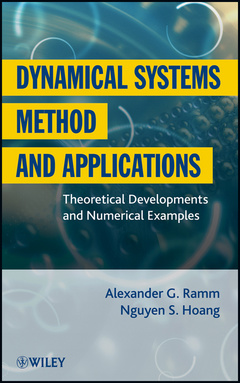Description
Dynamical Systems Method and Applications
Theoretical Developments and Numerical Examples
Authors: Ramm Alexander G., Hoang Nguyen S.
Language: English
Subject for Dynamical Systems Method and Applications:
163.43 €
In Print (Delivery period: 14 days).
Add to cart576 p. · 16.5x23.6 cm · Hardback
Description
/li>Contents
/li>Biography
/li>
The dynamical systems method (DSM) is a powerful computational method for solving operator equations. With this book as their guide, readers will master the application of DSM to solve a variety of linear and nonlinear problems as well as ill-posed and well-posed problems. The authors offer a clear, step-by-step, systematic development of DSM that enables readers to grasp the method's underlying logic and its numerous applications.
Dynamical Systems Method and Applications begins with a general introduction and then sets forth the scope of DSM in Part One. Part Two introduces the discrepancy principle, and Part Three offers examples of numerical applications of DSM to solve a broad range of problems in science and engineering. Additional featured topics include:
General nonlinear operator equations
Operators satisfying a spectral assumption
Newton-type methods without inversion of the derivative
Numerical problems arising in applications
Stable numerical differentiation
Stable solution to ill-conditioned linear algebraic systems
Throughout the chapters, the authors employ the use of figures and tables to help readers grasp and apply new concepts. Numerical examples offer original theoretical results based on the solution of practical problems involving ill-conditioned linear algebraic systems, and stable differentiation of noisy data.
Written by internationally recognized authorities on the topic, Dynamical Systems Method and Applications is an excellent book for courses on numerical analysis, dynamical systems, operator theory, and applied mathematics at the graduate level. The book also serves as a valuable resource for professionals in the fields of mathematics, physics, and engineering.
1 Introduction 3
2 Ill-posed problems 11
3 DSM for well-posed problems 57
4 DSM and linear ill-posed problems 71
5 Some inequalities 93
6 DSM for monotone operators 133
7 DSM for general nonlinear operator equations 145
8 DSM for operators satisfying a spectral assumption 155
9 DSM in Banach spaces 161
10 DSM and Newton-type methods without inversion of the derivative 169
11 DSM and unbounded operators 177
12 DSM and nonsmooth operators 181
13 DSM as a theoretical tool 195
14 DSM and iterative methods 201
15 Numerical problems arising in applications 213
PART II
16 Solving linear operator equations by a Newton-type DSM 255
17 DSM of gradient type for solving linear operator equations 269
18 DSM for solving linear equations with finite-rank operators 281
19 A discrepancy principle for equations with monotone continuous operators 295
20 DSM of Newton-type for solving operator equations with minimal smoothness assumptions 307
21 DSM of gradient type 347
22 DSM of simple iteration type 373
23 DSM for solving nonlinear operator equations in Banach spaces 409
PART III
24 Solving linear operator equations by the DSM 423
25 Stable solutions of Hammerstein-type integral equations 441
26 Inversion of the Laplace transform from the real axis using an adaptive iterative method 455
Nguyen S. Hoang, PhD, is Visiting Assistant Professor in the Department of Mathematics at the University of Oklahoma. He has published numerous journal articles in the areas of numerical analysis, operator theory, ordinary and partial differential equations, optimization, and inverse and ill-posed problems.
These books may interest you

Numerical Methods for Engineers 74.82 €



